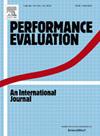Inference for dynamic Erdős–Rényi random graphs under regime switching
IF 0.8
4区 计算机科学
Q4 COMPUTER SCIENCE, HARDWARE & ARCHITECTURE
引用次数: 0
Abstract
This paper examines a model involving two dynamic Erdős–Rényi random graphs that evolve in parallel, with edges in each graph alternating between being present and absent according to specified on- and off-time distributions. A key feature of our setup is regime switching: the graph that is observed at any given moment depends on the state of an underlying background process, which is modeled as an alternating renewal process. This modeling framework captures a common situation in various real-world applications, where the observed network is influenced by a (typically unobservable) background process. Such scenarios arise, for example, in economics, communication networks, and biological systems.
In our setup we only have access to aggregate quantities such as the number of active edges or the counts of specific subgraphs (such as stars or complete graphs) in the observed graph; importantly, we do not observe the mode. The objective is to estimate the on- and off-time distributions of the edges in each of the two dynamic Erdős–Rényi random graphs, as well as the distribution of time spent in each of the two modes. By employing parametric models for the on- and off-times and the background process, we develop a method of moments approach to estimate the relevant parameters. Experimental evaluations are conducted to demonstrate the effectiveness of the proposed method in recovering these parameters.
状态切换下动态Erdős-Rényi随机图的推理
本文研究了一个涉及两个并行演化的动态Erdős-Rényi随机图的模型,每个图中的边根据指定的开、关时间分布在存在和不存在之间交替。我们设置的一个关键特征是状态切换:在任何给定时刻观察到的图取决于底层背景进程的状态,该背景进程被建模为交替更新过程。此建模框架捕获了各种实际应用程序中的常见情况,其中观察到的网络受到(通常不可观察的)背景进程的影响。例如,在经济学、通信网络和生物系统中都会出现这种情况。在我们的设置中,我们只能访问聚合量,例如观察图中活动边的数量或特定子图(如星图或完全图)的计数;重要的是,我们没有观察到模式。目标是估计两个动态Erdős-Rényi随机图中每个边的开、关时间分布,以及在每个模式中花费的时间分布。通过采用开关时间和背景过程的参数模型,提出了一种矩量法估计相关参数的方法。实验验证了该方法在恢复这些参数方面的有效性。
本文章由计算机程序翻译,如有差异,请以英文原文为准。
求助全文
约1分钟内获得全文
求助全文
来源期刊

Performance Evaluation
工程技术-计算机:理论方法
CiteScore
3.10
自引率
0.00%
发文量
20
审稿时长
24 days
期刊介绍:
Performance Evaluation functions as a leading journal in the area of modeling, measurement, and evaluation of performance aspects of computing and communication systems. As such, it aims to present a balanced and complete view of the entire Performance Evaluation profession. Hence, the journal is interested in papers that focus on one or more of the following dimensions:
-Define new performance evaluation tools, including measurement and monitoring tools as well as modeling and analytic techniques
-Provide new insights into the performance of computing and communication systems
-Introduce new application areas where performance evaluation tools can play an important role and creative new uses for performance evaluation tools.
More specifically, common application areas of interest include the performance of:
-Resource allocation and control methods and algorithms (e.g. routing and flow control in networks, bandwidth allocation, processor scheduling, memory management)
-System architecture, design and implementation
-Cognitive radio
-VANETs
-Social networks and media
-Energy efficient ICT
-Energy harvesting
-Data centers
-Data centric networks
-System reliability
-System tuning and capacity planning
-Wireless and sensor networks
-Autonomic and self-organizing systems
-Embedded systems
-Network science
 求助内容:
求助内容: 应助结果提醒方式:
应助结果提醒方式:


